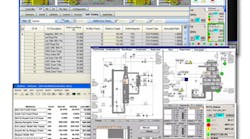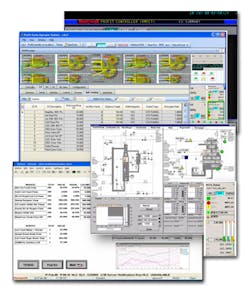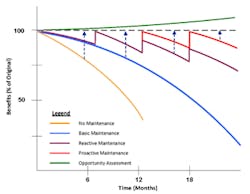The global industrial marketplace has increased pressure on facility operators to remain both competitive and profitable. For chemical manufacturers, the challenge is to run processes, typically involving large and interconnected sets of operations, at their optimal conditions while simultaneously maintaining multiple safety margins at acceptable levels.
For a growing number of sites, advanced process control (APC) and real-time optimization (RTO) are playing a key role in meeting operational and business objectives.
Yet, some chemical makers still don’t embrace APC technology, often because of outdated fears. This article aims to help overcome this reluctance by explaining how proper planning, implementation and maintenance of an APC strategy can result in tremendous improvements in plant efficiency and performance.
[javascriptSnippet ]
The ABCs Of APC
First, let’s cover some basics. APC is an intelligent and active software layer that sits above the distributed control system (DCS) or regulatory control layer in a manufacturing automation hierarchy. APC and RTO applications are designed to reduce changeability of critical variables and continuously adjust the process to guarantee the desired end result. The applications depend upon an accurate mathematical model of the manufacturing process; building that model is the first step in any implementation.
Many plant operators have learned to trust APC technology and appreciate its ability to make them more effective in their jobs. Today’s APC applications provide robust analytical tools and decision-support capabilities. These include comprehensive “move cause” scenario support, easier problem identification and faster diagnostics, as well as enhanced visualization for presentation of crucial information and integration/access to non-APC information (Figure 1).
Figure 1. Today’s advanced process control applications provide robust analytical tools and decision-support capabilities.
APC also enhances operational stability and consistency. Product and batch transitions are performed more quickly and in a uniform manner, translating directly to greater operational efficiencies and lower transition losses. In addition, the technology allows a manufacturer to run closer to desired targets and push constraints with more confidence. This leads to increased throughput as well as decreased consumption of raw materials and energy.
Advanced control technology should appeal particularly to a processor faced with operator shortages and low head counts. Current economic conditions are driving more companies toward APC so they can make do with fewer staff.
Applying The Technology
In the 1980s and 1990s, APC tools and techniques sometimes were difficult to use and needed special hardware for implementation, which raised costs. With today’s powerful computers, APC now is available anytime and everywhere — at lower capital cost and with greater return on investment.
One of the main hurdles in APC deployment is gaining acceptance from operators, particularly because they must relinquish control to the intelligence embedded within the system and accept changes affecting long-established procedures. Winning over operators requires efforts on two fronts: resolving technical issues; and simultaneously advising all those involved about how jobs will be handled going forward.
Typically, APC implementation takes place during the normal steady-state phase of a unit’s lifecycle. Plant owners increasingly are looking to expedite the benefits of the technology by introducing it at the conclusion of the guarantee period and having it functional within 3–6 months after the plant becomes operational.
As a preliminary, you must tune up the existing instrumentation, valves, controllers and control infrastructure to maximum performance. This on its own may yield substantial improvements. However, it won’t suffice to meet the larger objectives of APC deployment — namely, taking advantage of every opportunity to drive optimization of the plant.
Next, you must install online control-quality-monitoring software and then analyze process data on poorly performing control loops to identify the system dynamic. Finally, you must calculate new and improved tuning parameters for the control system.
Optimization is a stepwise procedure built on collaboration between process engineers and the control system team. It integrates planning, scheduling and management functions, and offers an advance, proactive view of all plant systems, allowing operators to push production limits while staying within equipment limitations.
Any facility implementing APC should conduct a comprehensive performance audit. This will identify key optimization areas and provide an estimate of target values (e.g., savings, emission reductions, etc.). Once these are agreed upon, the project team will implement APC with the aim of achieving the goals.
A plant, after optimizing its processes for the first time, should keep monitoring and tweaking operations to continually maximize production performance.
A facility usually will benefit from a gap analysis of the performance of its existing controls. This involves measuring the process variability of major units and calculating the variability expected if all controllers were turned off. In this way, the plant can determine how much variability the automation system is removing and, thus, the effectiveness of current controls.
For instance, a site might start by assessing the performance of the DCS’s proportional-integral-derivative controllers, monitoring how they perform and determining where there’s room for improvement. Then, the plant should evaluate the performance of individual process-critical equipment, so it can push each unit to its limit and squeeze the maximum revenues out of capital investments.
A plant, whether new or established, should consider use of an operator-training simulator (OTS) to support its implementation of APC technology. Industry experience shows that a realistic OTS model provides the best training environment for control room staff. Such an advanced system looks and feels like a real plant, with the same dynamics as a live process. An OTS is the answer to training operators effectively — validating procedures and shortening startups — leading to increased profitability (Figure 2).
Figure 2. A realistic model enables effective training of control room staff and offers other benefits as well.
With steady-state simulation on an OTS, a plant can evaluate prospective changes to control schemes offline and leverage models online for control and optimization. Dynamic simulation also allows re-use of investments in the virtual plant and provides advanced integration features for testing.
Furthermore, the availability of common tools drives greater efficiency and long-term sustainability in an APC environment. A plant can test control schemes and develop initial controller models much faster. It also can increase advanced application uptime by improving both operator acceptance and performance validation/troubleshooting.
Sustaining The Benefits
APC has proven its worth for optimizing complex plant processes — but implementing the technology is just a start. The benefits of APC can degrade over a short period of time if the application isn’t properly monitored and maintained (Figure 3).
Process equipment modifications, changes in operating strategy, alterations in feed rate and quality, debottlenecking, instrumentation degradation and fouling can contribute to deterioration in regulatory and economic performance of an APC system. In addition, in some developing regions, lack of skilled support staff can compromise ongoing performance.
As a result of these factors, some projects don’t sustain the benefits initially achieved.
Figure 3. Proper monitoring and maintenance are essential for retaining the full benefits of advanced process control.
Experience shows that sustaining APC performance isn’t always a straightforward task. For example, many plants fail to monitor uptime or assume uptime automatically equates to operational benefits. Just because a controller is running doesn’t mean it’s operating as intended.
If operators don’t understand the functions of a multivariable controller, they tend to “pinch in” on the manipulated variables — eliminating opportunities to optimize the process. Moreover, in some instances, operators simply turn off a controller if they don’t know how to handle an abnormal issue or if a problem arises during the night shift.
The biggest challenge in leveraging technology benefits is finding the time to analyze all the information generated by APC and RTO applications. This is due to the shortage of experienced staff in many facilities coupled with the loss of valuable intellectual property as older workers retire. (For details on what some operating companies are doing to retain expertise, see “Plants Grapple with Graying Staff.")
A chemical manufacturer generally will take one of three common approaches to sustaining advanced control. The company either designates a staff member to keep tabs on APC applications, purchases dedicated software to monitor control assets in real time, or employs an outside firm to watch over the whole operation. The required final automation and control performance largely drives the decision.
If APC monitoring is handled manually, then the designated individual follows a normal workflow, checking with the operations team on a periodic basis to pull up trends, review logbooks and determine any outstanding issues that must be addressed at the engineering level.
Opting for control-performance-monitoring software makes the job of sustaining APC assets much easier. Today’s web-based software augments human involvement by automating the collection of relevant data and distributing these data in a more meaningful and effective way. Condition-based applications are particularly beneficial for analyzing control asset performance. They can be used to configure metrics and reports that pinpoint the automation and process controls not operating to their potential as well as provide detailed analysis on the root cause of the performance degradation. The ability to do this from historical data ensures a plant can benchmark against its own goals or other facilities without the need for comprehensive testing.
Relying on a partner to monitor advanced control applications and identify ways to help improve performance makes an onsite APC engineer unnecessary. Major automation system suppliers can help a processing facility effectively implement and maintain APC. These vendors generally offer a unified technology platform, advanced engineering and operations tools, and an integrated user interface to drive and sustain benefits across the enterprise.
At a growing number of process plants, remote monitoring keeps tabs on the advanced control applications already in place, enabling personnel to access data via the web to perform a detailed analysis of the process. Such remote monitoring can manage APC at multiple sites, resolving issues quickly and simply with a secure remote system connection.
Using proprietary technology, advanced control experts generate key performance indicators and diagnostics on how controllers are functioning. With this information, they create weekly reports that identify problem areas, such as the beginning of a breakdown in model relationships and degrading of application performance. This provides clear direction to onsite engineers on the changes required to optimize controller performance.
Regardless of the situation, sustaining advanced control benefits requires a workflow that integrates all aspects of the APC lifecycle. This effort should encompass planned maintenance of all field instrumentation and final control elements used by the system, updating of process models after changing mechanical or thermodynamic properties of equipment, software upgrades and server maintenance.
Successful Applications
Process plant operators worldwide are finding that APC and RTO can maximize profits, increase capacity and improve operating efficiencies. The systems’ easier implementation has empowered companies to address a wider range of process conditions and business challenges.
For example, Canada’s Yara Belle Plaine Inc. was looking to improve the energy efficiency of its nitric acid plant by operating at consistent, stable, high levels of production while at the same time achieving tighter control of greenhouse gas emissions. With APC technology, the company has been able to maintain a higher average combustor temperature, which allowed it to reduce methane emissions by 25%. Close control of combustor backpressure has enabled an increase in the steam turbine speed that maximizes airflow and nitric acid production against multiple constraints. The biggest impact has come from much more stable and consistent operation.
South Korea’s LG Petrochemical Corp. wanted a world-class, cost-competitive naphtha-cracking center. To achieve this goal, the firm sought not only to increase production capacity but also to improve operating efficiency. RTO enables the plant to attain 5% greater olefin output than the previous best-sustained rate. It also reduces energy consumption in cold-side towers by 8% by lowering steam consumption in separation columns and energy in refrigeration circuits. Unit stability has increased significantly since the RTO implementation, and LG has achieved 95+% uptime for advanced applications and a very high level of operator satisfaction. Moreover, it has realized savings of approximately $100,000/yr by operating closer to ethylene product specifications.
Saudi Aramco in Saudi Arabia had issues with base-level regulatory control availability (>50% of loops in non-normal mode) at various operating facilities. Some plants had no standard processes for monitoring and maintaining critical assets, and lacked uniform procedures to prioritize maintenance. So, the company has implemented a consistent program to monitor APC applications as assets across all operations. This includes deployment of a continuous process-monitoring dashboard to allow for wide access to results. The number of loops in “normal” mode has significantly increased; the company also has seen a measurable boost in the economic performance of automation assets across the enterprise.
Seize The Opportunity
APC and RTO can benefit plants by improving the consistency of operations, extending asset life by reducing stresses on equipment, and leveraging control system expertise in an aging workforce environment.
Even with these benefits, it’s important to realize the sustainability of APC technology depends upon the knowledge and skills of people involved in the maintenance of existing applications.
PERRY NORDH is Calgary, Alberta-based product manager, advanced control and optimization for Honeywell Process Solutions. E-mail him at [email protected].





